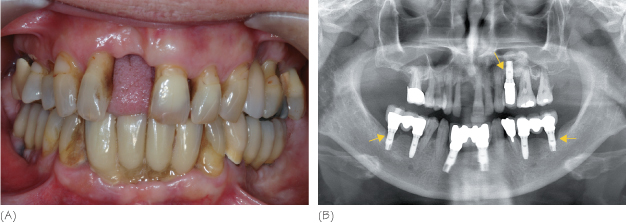13
Patient evaluation: the patient at risk for dental implant failure
We have not identified in the literature an individual risk factor that might be a contraindication for implant survival. Most studies indicate that dental implants can be successfully placed and maintained in patients exhibiting a variety of systemic diseases and congenital defects. However, the level of evidence indicating a risk of dental implant failure or complication associated with the health state of the patients is low, i.e. restricted to case reports and case series. Thus, dental implant indications must be thoroughly and individually evaluated, according to the patient’s profile. The decision-making process must include the severity of the risk factors and/or, maybe most importantly, their combination in the same individual (Fig. 13.1). In any case, patients need to be informed of the possibility of implant complications.
Figure 13.1 Patient at risk for implant failure: combination of smoking and periodontitis. (A) Clinical view of a periodontitis patient 4 years after implant placement. The patient is a heavy smoker, and has not received a periodontal treatment. (B) The panoramic radiograph indicates bone loss around teeth and implants (yellow arrows).

The following list indicates potential risk factors that have been adequately documented, and the overall conclusions that can be drawn.
Age
There is no upper limit in terms of age. As a general rule, the lower limit for implant placement is 18–19 years, when an adolescent’s jaw growth and development can be considered to be complete. However, this rule can be broken with children suffering from hypondontia or anodontia, such as in ectodermal dysplasia, because the benefit/risk analysis is in favor of implant placement.
Smoking
There is strong evidence that smokers are at greater risk for peri-implantitis (OR 3.6–4.6) and radiographic marginal bone loss (OR 1.95–10) than non-smokers (Mayfield et al., 2009). However, the majority of the studies report implant survival rates of 80–96% in smokers (Cochran et al., 2009). There is some evid/>
Stay updated, free dental videos. Join our Telegram channel

VIDEdental - Online dental courses


